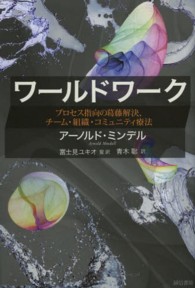- ホーム
- > 洋書
- > 英文書
- > Science / Mathematics
Full Description
This open access book examines the historical development of the concept of the virtual particle, from the first prominent appearance of virtual entities in quantum physics in the Bohr-Kramers-Slater (BKS) theory (1924) to the most common representation of virtual particles in Feynman diagrams (1949).
Through a pragmatically informed approach to concept formation, focusing on the different representations of virtual entities and their role in theoretical practice, this work unravels the (dis)connections between the concepts of "virtual oscillators" (early 1920s), "virtual transitions" (the late 1920s to mid-1940s), and, finally, "virtual particles" (mid-1930s to late 1940s). The shifts and continuities in the conceptual development must be understood within the broader transformation of the theoretical framework, from the so-called Old Quantum Theory to the emergence of quantum electrodynamics (QED) and quantum field theory of the 1930s, culminating in the reconfiguration of the practice of QED in the hands of Richard Feynman in the late 1940s. A key pragmatically informed feature uniting these concepts is their shared function: they extended the set of possible processes and rendered these possibilities effective.
This book will be of interest to historians and philosophers of physics and mathematics.
Contents
Chapter 1. Introduction.- Chapter 2. How to conceive of the concept of virtual particles in a historical study of its development.- Chapter 3. The community of practitioners.- Part I. From virtual oscillators to virtual transitions (1923-1929).- Chapter 4. The BKS theory and the Light Quantum Hypothesis: virtual entities and transitions to intermediate states, but in different conceptual frameworks (1923-1925).- Chapter 5. Dirac's verbal model: Making transitions a quantum concept (1927).- Chapter 6. The Raman effect: How virtual transitions became "virtual" (for the first time) and real transitions were excluded from the conception of scattering (1928-1929).- Part II. Theoretical practice with virtual transitions (1928-1942).- Chapter 7. Scattering and the sea: Antiparticles and intermediate states (1928-1931).- Chapter 8. The practice of time-dependent perturbation theory (Part I): Formal and conceptual extensions (1929-1936).- Chapter 9 The practice of time-dependent perturbation theory (Part II): Virtual possibilities, modes of representation, and the reprise of the "Schüttelwirkung" (1934-1942).- Part III. From virtual transitions to virtual particles (1930-1949).- Chapter 10. In between: Traces of the virtual particle during the 1930s.- Chapter 11. Outlook: Feynman, diagrams, and virtual particles (1948-1949).- Part IV. Analysis, Summary, and Conclusion.- Chapter 12. Representations and Practices in the Formation of the Virtual Particle Concept.








